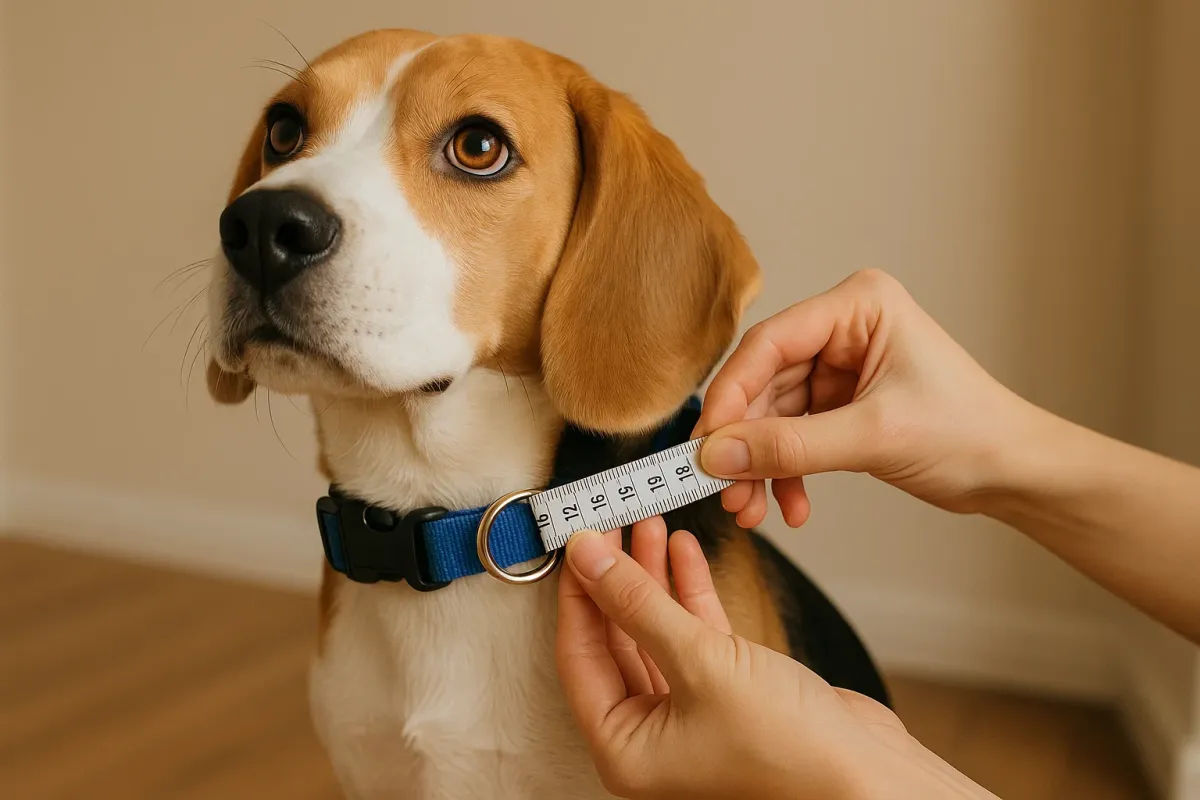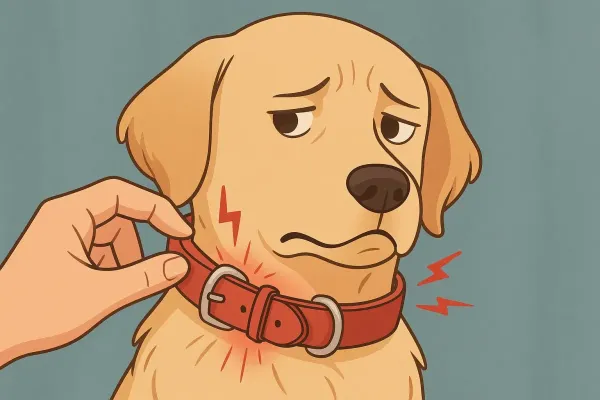
Choosing the right collar size for your dog is essential for their comfort and safety. A collar that’s too tight can cause chafing or injuries, while one that’s too loose can make it easier for the dog to slip out. With a few simple steps, you can properly measure your pet’s neck and ensure the collar fits perfectly.
In this guide you’ll learn how to measure your dog’s neck, which size suits each type of dog, and what factors to consider before buying a collar.
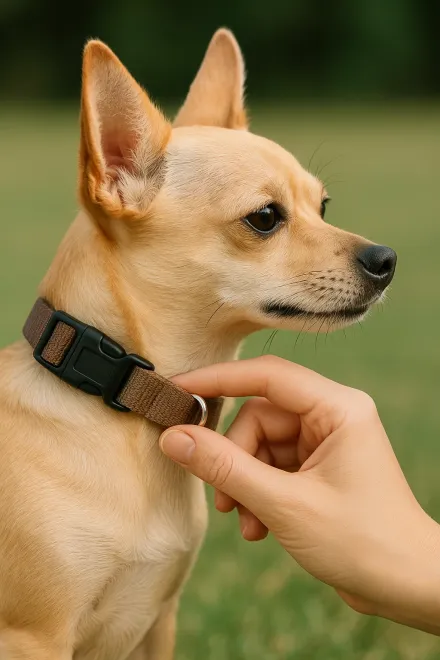
Why is it important to choose the right collar size?
Choosing the correct dog collar size directly impacts your pet’s daily well-being. An inappropriate size can cause physical discomfort, chafing, or even neck injuries, especially in small breeds or those with sensitive skin. As specialists in dog collars, we know that a proper fit makes the difference between a pleasant walk and an uncomfortable experience for your pet.
When a collar is too tight, it can cause skin irritation, hair loss, and trouble breathing. On the other hand, if it’s too loose, there’s a risk the dog could easily slip free, compromising their safety on the street. Both extremes should be avoided with accurate measuring and quality materials.
A well-chosen collar provides comfort, control, and protection. It lets you attach the leash without excessive pressure and ensures your dog carries identification comfortably. Padded models or those with adjustable closures help distribute tension and adapt to the neck’s natural movement.
In the image below you can see an example of a proper fit: the collar is snug without squeezing, allowing you to insert two fingers between the neck and the collar. This simple check ensures comfort and helps prevent long-term injuries.
How to measure your dog’s neck step by step
Measuring your dog’s neck correctly is the first step to choosing a comfortable, safe collar. Accurate measurement prevents chafing, excessive pressure, or the dog slipping out. Below is a clear, practical, and very detailed guide to help you get it right the first time.
What you’ll need
- Flexible measuring tape (sewing type). If you don’t have one, use a string and then measure it with a ruler.
- Paper and pen to note the exact measurement in centimeters.
- Comb or brush (useful for long or dense coats).
- Treat so your dog associates the process with something positive.
- Helper (optional) to gently hold or distract while you measure.
Step-by-step measuring (1–5)
- Stand your dog up and keep them relaxed. Avoid measuring while lying down or hunched; in a natural posture the neck circumference is more accurate.
- Find where the collar will sit. Wrap around the mid-neck (between the base of the skull and the top of the chest). This is where a collar rests most stably.
- Pass the tape around the neck without squeezing. The tape should touch the hair or skin but not press in. Note this base measurement in centimeters.
- Apply the “two-finger rule”. Insert two fingers between the neck and tape to simulate comfort slack. If you can’t insert them without pressure, add 1–3 cm depending on the dog’s size. If there’s too much space, repeat the measurement with the tape a bit snugger.
- Round and verify. Round to the nearest half centimeter and measure a second time to confirm. If you’re between two commercial sizes, choose the larger and make sure the collar is adjustable.
Quick tip: also note the minimum and maximum comfortable measurements you observed (e.g., 33–36 cm). This will help you pick collars with a compatible adjustment range.
Tips by coat type or age
- Long or very dense coats: brush before measuring. Consider adding 1 cm to compensate for coat volume, especially if the hair compacts when wet.
- Growing puppies: measure every 2–4 weeks. Prioritize light, highly adjustable collars. If you’ll use parasite preventatives, always respect the minimum recommended age.
- Small dogs with delicate necks: choose comfortable, padded collars 1–1.5 cm wide. Avoid heavy hardware that adds unnecessary pressure.
- Brachycephalics or sensitive trachea: prioritize wide, soft, very well-fitted collars, and consider a harness for intense walks. The goal is to distribute pressure.
- Very active or pulling dogs: measure with the dog moving gently, walk a few steps, and measure again. Also review training guides if pulling is constant.
With this method you’ll get a reliable measurement and, most importantly, a comfortable fit that protects your dog’s skin and breathing. Remember, proper slack lets you slide two fingers between collar and neck without effort.
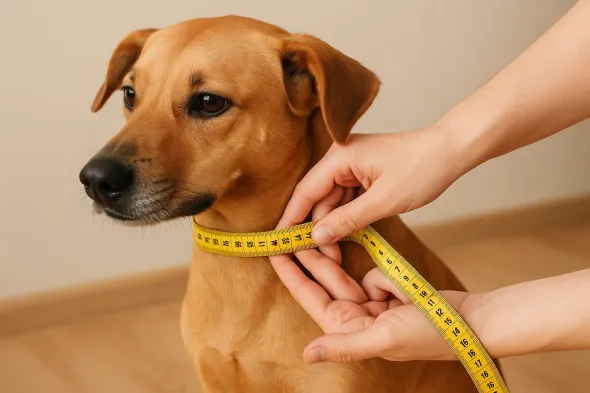
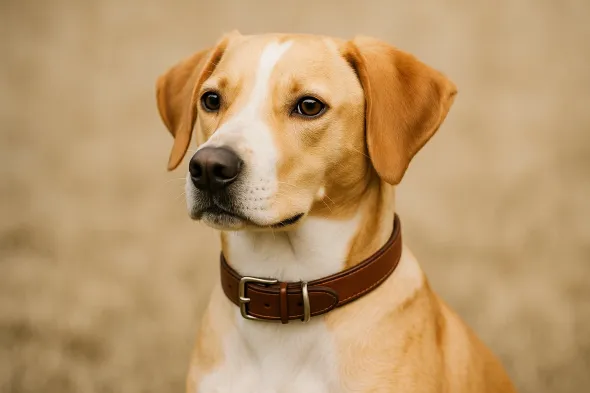
What to do with the measurement
Compare your measurement with each collar’s adjustment range, for example 28–36 cm. Make sure your number falls within that range with enough leeway to slightly loosen or tighten depending on the moment, season change, shedding, or weight variations.
- Collar width: for small dogs, 1–1.5 cm; medium, 2 cm; large, 2.5–3 cm. Greater width distributes pressure better.
- Material: soft nylon or neoprene for everyday comfort; supple leather for durability; avoid rigid or rough surfaces if the skin is sensitive.
- Buckle and hardware: look for sturdy buckles and a well-welded D-ring. Check that the hardware weight doesn’t tip the collar down on small dogs.
Common mistakes and how to avoid them
- Measuring while the dog is curled up or lying down: yields a smaller figure and makes the collar too tight in real use.
- Skipping comfort slack: if two fingers don’t fit, there’s a risk of chafing and discomfort when swallowing or panting.
- Choosing size by “S, M, L” without checking centimeters: sizes vary across brands; always prioritize the measurement in cm.
- Forgetting growth: with puppies, check the fit often. Switching sizes in time prevents unnecessary pressure.
- Not rechecking after adding accessories: ID tags or GPS devices add weight; recheck the slack.
If you measure your dog’s neck correctly and choose a collar made of soft, durable materials, you’ll strike the perfect balance between comfort and safety. A small detail that greatly improves their daily well-being.
Size guide by dog type
Picking the right collar size depends on each dog’s size, build, and strength. A collar that fits properly improves comfort, prevents injuries, and lets you maintain balanced control during walks. Below you’ll find a practical guide showing which measurement range and collar type tend to work best for each group of dogs.
This information will help you choose correctly, avoiding collars that are too tight or too loose and ensuring maximum safety and well-being for your canine companion.
🐕 Small dogs
Small dogs, such as Chihuahuas, Yorkies, or Pomeranians, typically have a neck circumference between 20 and 30 cm. They need lightweight, padded collars made from soft materials like nylon or thin neoprene. The ideal width is 1 to 1.5 cm to avoid chafing and maintain natural neck mobility.
🐾 Medium dogs
Breeds like Beagles, Cockers, or Border Collies usually measure 30 to 40 cm around the neck. They can use flexible leather collars or reinforced nylon with a soft lining. A width of about 2 cm helps balance control and comfort, avoiding localized pressure during moderate pulling.
🦮 Large dogs
Labradors, German Shepherds, or Rottweilers often have necks between 40 and 60 cm. Ideally, choose a wide collar (2.5–3 cm), sturdy and padded, with robust metal hardware. This type distributes pressure better and offers greater safety during outdoor activities.
🐶 Puppies
During growth, neck size changes quickly. Highly adjustable, very lightweight collars that can adapt every few weeks are recommended. It’s important to check them frequently to avoid tightness and to prioritize soft, breathable materials.
😮💨 Brachycephalic dogs or sensitive necks
Breeds like French Bulldogs, Pugs, or Shih Tzus have a more exposed trachea. Their collars should be very wide, cushioned, and precisely fitted. The correct slack—two fingers between neck and collar—prevents discomfort when breathing or swallowing.
👴🐕 Senior dogs
Older dogs or those with delicate joints need soft, padded collars that are easy to put on and take off. An ergonomic, wider model helps avoid pressure on sensitive areas and provides stable support without discomfort.
Using the correct collar size is just as important as choosing a good material. Measure your dog’s neck precisely, add comfort slack, and select the model that best suits their size and lifestyle. A good fit means more safety, less risk of injury, and much more enjoyable walks for both of you.
Tips for a perfect fit
A well-fitted collar not only improves your dog’s comfort but also prevents injuries and ensures proper control during walks. Below are some practical tips to make sure the collar fits your pet’s neck optimally.
The two-finger rule
This is the simplest and most effective reference for checking fit. Once the collar is on, you should be able to slide two fingers between the neck and the collar without difficulty. If they don’t fit or there’s too much space, adjust the size until you achieve that balance. It’s the safest way to avoid a collar that’s too tight or too loose.
Check the fit regularly
A dog’s neck size can change over time due to growth, shedding, weight changes, or coat changes. That’s why you should check the fit at least once a month. For puppies or breeds with dense coats, do it every few weeks. This helps prevent skin marks or the collar losing effectiveness.
Adjustable vs. fixed collars
Adjustable collars are recommended for most dogs because they adapt to small changes in neck size. They’re especially useful for puppies or dogs with seasonal variations in weight or coat. Fixed collars, while sometimes more stylish or durable, must be chosen very carefully so they fit perfectly from the start and don’t create excessive pressure.
Materials that adapt best
Material directly influences comfort. Nylon is lightweight, affordable, and durable—ideal for daily use. Neoprene provides soft, breathable padding, great for sensitive skin. Supple leather offers durability and a pleasant feel that breaks in to the neck over time. Avoid rigid or rough materials, as they can cause chafing or irritation in the long run.
By following these tips, your dog’s collar will stay comfortable, safe, and in the right condition to accompany you on every walk.
Common mistakes when choosing a collar
Choosing the right collar seems simple, but it’s easy to make mistakes that affect your dog’s comfort and safety. Knowing the most frequent pitfalls will help you avoid them and make a more informed decision, ensuring your pet enjoys every walk without discomfort.
Choosing by design, not by size
One of the most common mistakes is letting the collar’s looks guide you without checking the actual size. A pretty model that fits poorly can be uncomfortable or even dangerous. Before buying, be sure to measure your dog’s neck and review the adjustment range indicated by the manufacturer.
Measuring with a leash or collar on
Some owners measure the neck while the dog is wearing a collar or leash, which produces an incorrect number. Always measure directly on the neck, with no accessories, and apply the two-finger rule to ensure proper slack.
Ignoring growth
In puppies and young dogs, neck size changes quickly. Not adjusting or replacing the collar in time can cause excessive pressure or skin marks. It’s important to check the measurement regularly and opt for adjustable models that can adapt to the dog’s development.
Buying generic sizes without checking real measurements
Labels like S, M, or L aren’t universal—each brand can use a different system. The correct approach is to look at the centimeters covered by each size and compare them to your dog’s actual neck measurement. Only then will you avoid mistakes and guarantee a precise fit.
Final tip: spending a few minutes properly measuring your dog’s neck can be the difference between a comfortable walk and one full of pulling or discomfort. A well-chosen collar reflects care, attention, and respect for your companion’s well-being.
Frequently asked questions about choosing the right collar size for your dog
How can I correctly measure my dog’s neck?
Use a flexible measuring tape and wrap it around the middle of the neck. Leave enough space to insert two fingers between the neck and the tape; that slack ensures a comfortable, safe fit.
What if my dog is between two sizes?
When in doubt, always choose the larger size, especially if the collar isn’t elastic. This prevents excessive tightness and gives you room to adjust if needed.
How often should I check the collar size?
It’s recommended to check the fit once a month. For puppies or fast-growing young dogs, do it every two weeks to avoid excessive pressure on the neck.
How do I know if the collar is too tight?
If you can’t comfortably insert two fingers between the neck and the collar or you notice marks on the skin, it means it’s too tight. Loosen the buckle or move up a size.
Which materials are most comfortable for daily use?
Padded nylon, neoprene, or supple leather collars are the most comfortable. They adapt well to the dog’s neck, are breathable, and reduce the risk of chafing or irritation.
Is it advisable to leave the collar on all day?
No. It’s better to remove it at home or while your dog sleeps to prevent skin irritation and let the neck rest. Put it on only during walks or outdoor activities.
Are adjustable collars better than fixed ones?
Yes, adjustable collars offer greater versatility and adapt better to changes in your dog’s size or weight. Fixed collars must be chosen with more precision and used only if they fit perfectly.
How do I choose the right collar width?
It depends on dog size: 1–1.5 cm for small dogs, 2 cm for medium, and 2.5–3 cm for large dogs. A wider collar distributes pressure better and is more comfortable.
What mistakes should I avoid when buying a collar?
Avoid choosing by design, measuring with a collar on, using generic sizes, or forgetting about the dog’s growth. Spending a few minutes measuring correctly prevents discomfort and future problems.
When should I replace the collar with a new one?
Replace it if you notice wear, stiffness, broken stitching, or bad odor. A worn collar can break easily or make your dog uncomfortable.

